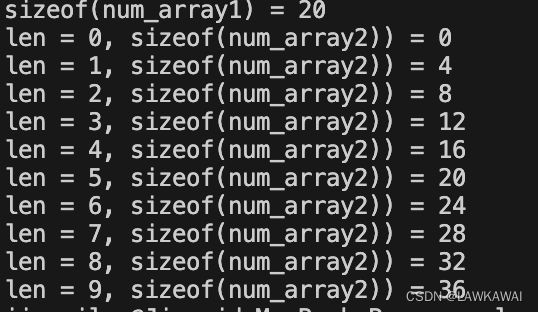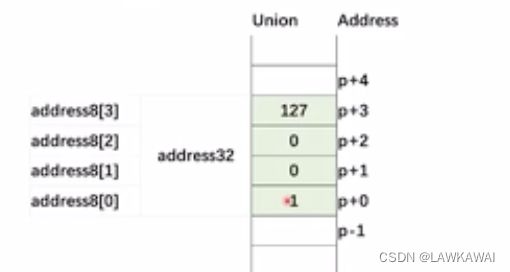【CPP】数据结构
#1- Arrays
Arrays
- A contiguously allocated memory
- Fixed number of objects (The array size cannot be changed)
- Its element type can be any fundamental type (int, float, bool), structure, class, pointers enumeration
# array.cpp
#include Variable-length arrays
- If the length is not an integer constant expression, the array will be a variable-length one.
#variable-array.cpp
#include Arrays of unknown size
-
The number is not specified in the declaration
-
The arguments of a function
#unknown-size-array .cpp
#include Element accessing
int array1[4] = {9, 8, 7, 6};
int array2[4];
array2 = array1; // error!
array2[0] = array1[0]; // okay
array2[1] = array1[1];
array2[2] = array1[2];
array2[3] = array1[3];
- No bounds-checking in C/C++
# index-bound.cpp
#include 超出边界也没事,直接取越界的地址
- Arrays are not objects in C/C++ (different with Java)
- Arrays can be regarded as address
优点是数据读写很快
Multidimensional arrays
#md-array.cpp
#include const Arrays
- Used as function arguments
#const-array
#include 外部是普通数组,进入函数后变成const不能进行修改,可以放心使用
2- Strings
Array-style strings
- An array-style string (null-terminated strings/arrays of characters) is a series of characters stored in bytes in memory
- This kind of strings can be declared as follows
#initchar.cpp
#include 字符串的结束标志:“\0”,碰到就结束
strlen(): 碰到"\0" 才结束计算长度,所以要多存一个字符’\0’, 否则会越界
String literals
- it isn’t convenient to initial a string character by character
- String literals can help
char name1[] = "Southern University of Science and Technology";
char name2[] = "Southern University of " "Science and Technology";
char name3[] = "ABCD"; // how many bytes for the array?
const wchar_t[] s5 = L"ABCD";
const char16_t[] s9 = u"ABCD"; // since C++11
const char32_t[] s6 = U"ABCD"; // since C++11
String manipulation and examination
- Copy
char * strcpy(char* dest, const char * src);
strcpy 对于长度不够的字符串会在后面字符串后面字节拷贝,越界不安全
Safer one:
char *strncpy(char *dest, const char *src, size_t count);
count: dest 和 src的较小值
- Concatenate: appends a copy of src to dest
char *strcat(char *dest, const char *src);
- Compare
int strcmp(const char *lhs, const char *rhs);
# stringop.cpp
#include String class
- Null-terminated strings are easy to be out of bound, and to cause problems.
- string class provides functions to manipulate and examine strings.
#stdstring.cpp
#include - Different types of strings
std::string
std::wstring
std::u8string // C++20
std::u16string // C++11
std::u32string // C++11
string类也是没有越界检查
3- Structures Unions and Enumerations
struct
- A struct is a type consisting of a sequence of membes
- The members are allocated in an orders sequence.
# struct.c
#include 在C编译器中,声明struct变量一定要在前面加struct,否则编译有错
但在C++编译器中,即使不在变量声明前加struct也不会报错
在C编译器中,除非在struct定义时加上typedef,这样的话就可以在声明时不加struct,这是因为你定义了一个新的类型
typedef
struct _Student{
char name[4];
int born;
bool male;
} Student;
Structure padding
- In order to align the data in memory, some empty bytes will be padded
# structpadding.cpp
#include 绝对0地址(变量开始的地址)一般是4的倍数或8的倍数
如果8对齐,可以直接装载到寄存器里
如果跨过8,则一次可能装载不完,需要装载两次
所以宁可牺牲两个,也往上放一放
struct in C and C++
-
struct and class in C++ are identical except for several features
-
No typedef needed in C++
Union
- union declaration is similar to struct declaration
- The storage of members overlaps/shared
- sizeof(union ipv4address) is 4
#union.cpp
#include enum
- enum makes a new type
- It provides an alternative to const for creating symbolic constantt
- Its members are integers, but they cannot be operands in arithmetic expressions
enum color {WHITE, BLACK, RED, GREEN, BLUE, YELLOW, NUM_COLORS};
enum color pen_color = RED;
pen_color = color(3); //convert int to enum
cout << "We have " << NUM_COLORS << " pens." << endl;
//pen_color += 1; //error!
int color_index = pen_color;
color_index += 1;
cout << "color_index = " << color_index << endl;
An example with struct, union and enum
#enum.cpp
#include 4-typedef
typedef
- typedef can create an alias for a type
- It can be used to replace a possibly complex type name.
#typedef.cpp
#include Typical typedef usages
#_uint8_t.h
#ifndef _UINT8_T
#define _UINT8_T
typedef unsigned char uint8_t;
#endif /* _UINT8_T. */
# if defined (_LP64)
typedef int wchar_t;
#else
typedef long wchar_t;
#endif

















